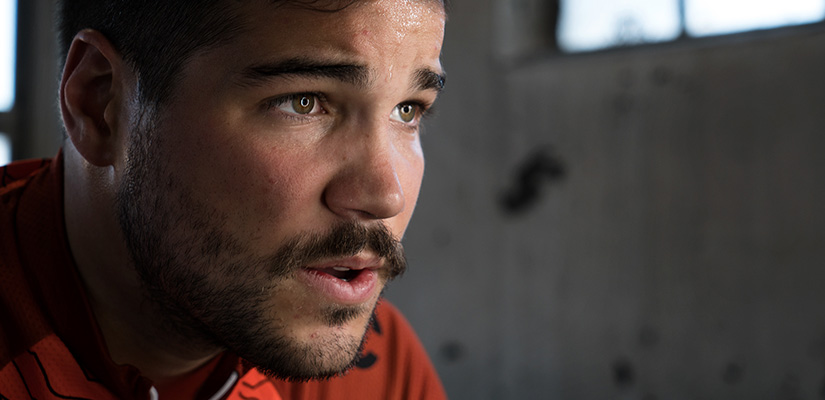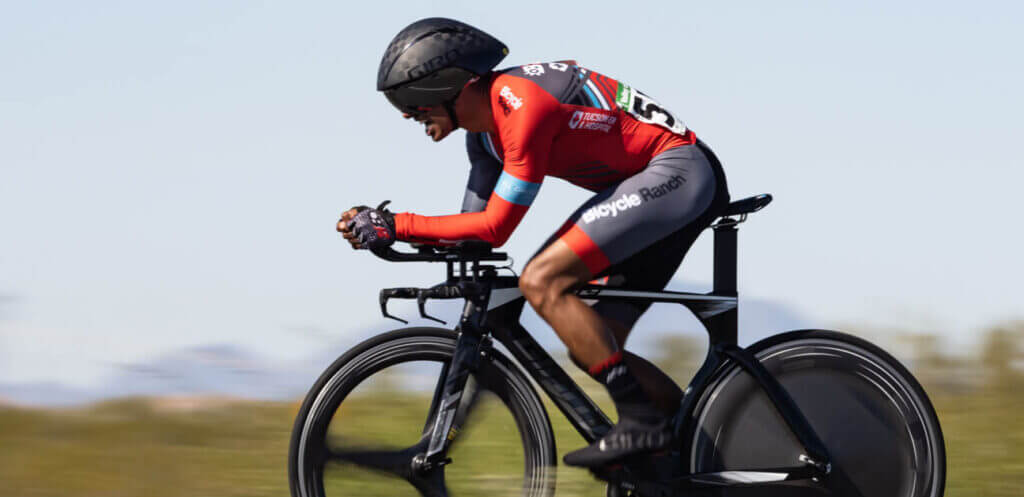Want to Excel In a New Cycling Discipline? Blame Genetics Last

When a rider decides to try a new discipline different from the one they already excel in, the mind tends to get in the way.
We tell ourselves our bodies are the problem. But really, a huge percentage of getting over the hump of starting a new style of racing is mental. You can train yourself to be the type of athlete you want to be. It just takes a shift in focus both on — and off — the bike.
Q: How can I excel at long-distance endurance riding when my background is the opposite?
In episode 50 of the Ask a Cycling Coach, we answered a question submitted by a rider named David. His full question was this:
I’ve always been a very strong crit rider in that I could hang with the pack and contest the final sprint. In recent years, I’ve migrated to Half IRONMAN triathlon. Despite what I view as a healthy improvement in FTP from 177 to 218 after several years off from the bike, I still find my body is still geared to high wattage sprints for short durations. I’m using the Half-Distance Triathlon Low Volume plan. It is working great, but was curious what, if anything, can I do to shed the “old” cyclist who was successful in sprints versus a pure long duration, high FTP rider.
Summary of David’s question: He’s a former crit rider. After some time off the bike, he’s training for a Half IRONMAN. He wants to know if there’s anything he can do to become a strong, long-duration rider despite feeling like his body is suited for sprinting.
A: Don’t blame genetics first
Yes, there’s a chance David has a genetic predisposition toward being one type of rider. That’s a tough thing to get away from. But, that doesn’t mean he can’t become the type of athlete he wants to be. It takes proper training, which he’s already gotten right by being on the Half-Distance Triathlon plan. It also takes looking hard at not only physical limiters, but mental ones as well.
It’s easy to blame our bodies when hard work gets in the way of achieving our goals. It’s not so easy to put the blame on our own mental limitations. We’ll get more into that in a minute. But first, let’s first talk about how to address physical limiters.
How to Address a Physical Limiter
A limiter is anything that keeps you from riding at the full potential of your athletic ability. In David’s case, his limiter is steady-state power. So, that’s what he has to focus on. Currently he’s on a low-volume plan which places more emphasis on higher intensity, shorter duration workouts.
If he wants to change his training to address his limiter, he has two options: Tweak his current low volume Half-Distance Triathlon training plan, or change to a higher volume plan that incorporates longer steady-state efforts, i.e. more of what he needs to breakdown his physical limiter.
Family and work-related travel are the reasons David is on a low-volume plan. Since his time available to train is constrained, a step up to a mid-volume plan might not make sense for him. Instead, to start increasing his capacity for steady-state work, he can modify his current plan. There are a few options here:
Option 1
Since David is currently in his specialized training phase, the composition of the Half-Distance triathlon Specialty plan addresses exactly what he needs to work on. So, that already puts him in a good spot to start improving his limiter, which is his muscular endurance, i.e. Threshold workout capabilities. That said, if he wants to address his limiter even further, he has the option to pluck a slightly tougher version of his Tuesday bike workout (say a 60-minute workout) from a higher volume Half-Distance triathlon plan (like a 90-minute workout). He could keep up with this practice of swapping shorter workouts for longer ones until he finds he’s able to maintain a mid-volume plan. It’s all about baby steps.
Option 2
If David wasn’t in his specialized training phase and already doing workouts that address his limiter, he could go from swapping his low-volume plan workouts with mid-volume plan workouts to replacing his bike workouts with others that better address his limiter. This could mean fully swapping out VO2 max workouts for Threshold workouts since he’s already fairly strong at the shorter, harder stuff. It’s easy to do this in TrainerRoad. You can find appropriate replacement workouts on the left-hand side of the TrainerRoad workouts page. Use the power zone filter to sort through workouts and find a suitable replacement to address your limiter.
Option 3
If David’s race schedule allows, he could completely divert from his specialty plan and return to something like the Sustained Power Build plan. This would allow him to do maintenance run and swim workouts while he improves his sustainable power on the bike.
Takeaway
When you’re making adjustments to your plan, don’t automatically assume you need to ramp up your training stress to increase your fitness. That’s not always the best (or most realistic) solution for every rider. Instead, focus on getting more of the right kind of stress — the kind of stress that addresses your limiter — into your training.
How to Address a Mental Limiter
Why is that so many riders, like David, think there’s more they could be doing when they’re already doing everything right? Like so much of cycling, it’s mental — even when you’re sticking to a properly structured training plan.
In the book Faster by Michael Hutchinson, he references a comment made by Dan Hunt, the Former Performance Director of British Cycling and TEAM SKY. He said: “Ideally, what we want is a rider like a robot.” He made that comment leading up to the London Olympics. If Hunt’s riders could keep their minds from giving in to the pressures and distractions of the Olympic Velodrome, everything would be easy. Do it like robots — that’s the ideal, but it’s sure as heck not realistic. Cyclists aren’t robots. Hunt, of course, knew this.
Whether you’re a rider training in a familiar discipline or you’re branching out into something new, mental battles are inevitable. They’re part of every sport, especially cycling. Sometimes there isn’t just one reason why you’re not meeting your performance expectations, but the way you’re approaching your training.
For those of you who are in a situation similar to David’s, here’s some advice from our cycling experts on how to transition from one cycling discipline to another:
Forget what you’re already good at.
Too many riders have identity issues. They latch onto the type of rider they once were. Don’t do this. It’s best to approach your foray into a new discipline as an athlete — not as a former crit rider, mountain biker or triathlete. You’re an athlete. What athletes know best is that gains don’t happen overnight. Cycling success takes commitment, time and whole lot of hard work. But you knew that already.
Don’t compare yourself to the competition.
Compared to bike racing, triathlon competitions are grouped by age. For someone like David, this means he could be going up against former or soon-to-be professional triathletes when he races. There’s a lot of psychology at play when you see your numbers compared to those of such high-level competitors. So, ignore them. In triathlon, there’s no real basis for proper comparison anyway, unless you researched every one of your AG competitors — but who has time for that?
Listen to Experts Discuss This Training Topic and More on the Ask a Cycling Coach Podcast
David’s question and other cyclists’ questions were answered on episode 50 of the Ask a Cycling Coach podcast. Listen to the episode’s full recording below.
Additional Notes
TrainerRoad’s Ask a Cycling Coach podcast is dedicated to making you a faster cyclist. It gives you the chance to get answers to your cycling and triathlon training questions from USAC certified coaches Chad Timmerman, Jonathan Lee and special guests. Learn more about other topics we covered in the latest episode with our resources below:
- How to adjust your training during the offseason
- How to train for criterium racing
- How to pace an FTP test
- How the 8 Minute Test works
- What type of racing are you best at, and how do you find it?
- Does fitness for one type of racing translate to another?
- How to train for cyclocross racing
- Is fasted training different than fat adaptation?
- Is it normal to have your cadence drop during hard efforts?
- How to increase your cadence
- Is training at night bad?
- How to recover even after training at night
- Hacks and tips on how to improve the quality of your sleep
- How to get back into training after a long hiatus
- Is it okay to repeat a base training phase?
- How to stay motivated during base training
- How to train with a busy schedule
- What is better: Normalized Power or Average Power?
- Is it possible for normalized power to be lower than average power?
- Which matters more during an interval: live power output or average?
- How to transition to a different type of cycling
- Can crit riders be good endurance riders?
- Can endurance riders be good crit racers?
- How to race successfully out of your element
- Can you change the type of athlete you are, or are you stuck?
- How age affects your ability to raise FTP
- Thyroidectomies and cycling
- Upcoming podcast topics from Interbike!
If you have a question that you’d like to ask Coach Chad, submit your question here. We’ll do our best to answer it on the next episode of the Ask a Cycling Coach podcast.
